A Painted World Map for Worship
Dr. Gautama V. Vajracharya
The Sunderland Collection is privileged to own this beautiful hand-painted map of the world from Nepal, dated 1711 CE.
We are delighted to present this essay by Dr. Gautama Vajracharya, on the history and context of the map. More information about Gautama and his work can be found at the end of the essay.
A Painted World Map for Worship: an 18th Century Contribution by a Malla Prince of the Kathmandu Valley
by Dr. Gautama V. Vajracharya
Introduction
During the latter half of the medieval period (1382-1769), Kathmandu, the capital city of modern Nepal, was one of three neighbouring principalities ruled by the Malla kings; the other two principalities were Patan and Bhaktapur. The kings and members of the royal families, as well as wealthy merchants from these three principalities, adorned their cities, palaces, residential courtyards, water fountains, private shrines, and living rooms with luxurious works of art.
The primary source of their economy was the flourishing trade with India and Tibet, along with two seasonal harvests of rice and wheat. The trade route between these two neighbouring countries passed through the valley. The Malla kings constantly fought each other for control of trade routes.
More importantly, however, there was a creative rivalry among the royal families of the valley that lasted for over three centuries. As a result, their palaces became showcases of Nepalese art and architecture, furnished with unique features such as the golden fountains, designed after the mythical creature makara, three-story-high stone pillars surmounted by portrait statues of the king and queen, and life-size golden images of youthful goddesses flanking the main door of the pagoda-style temple of the tutelary goddess of the Malla dynasty [1].
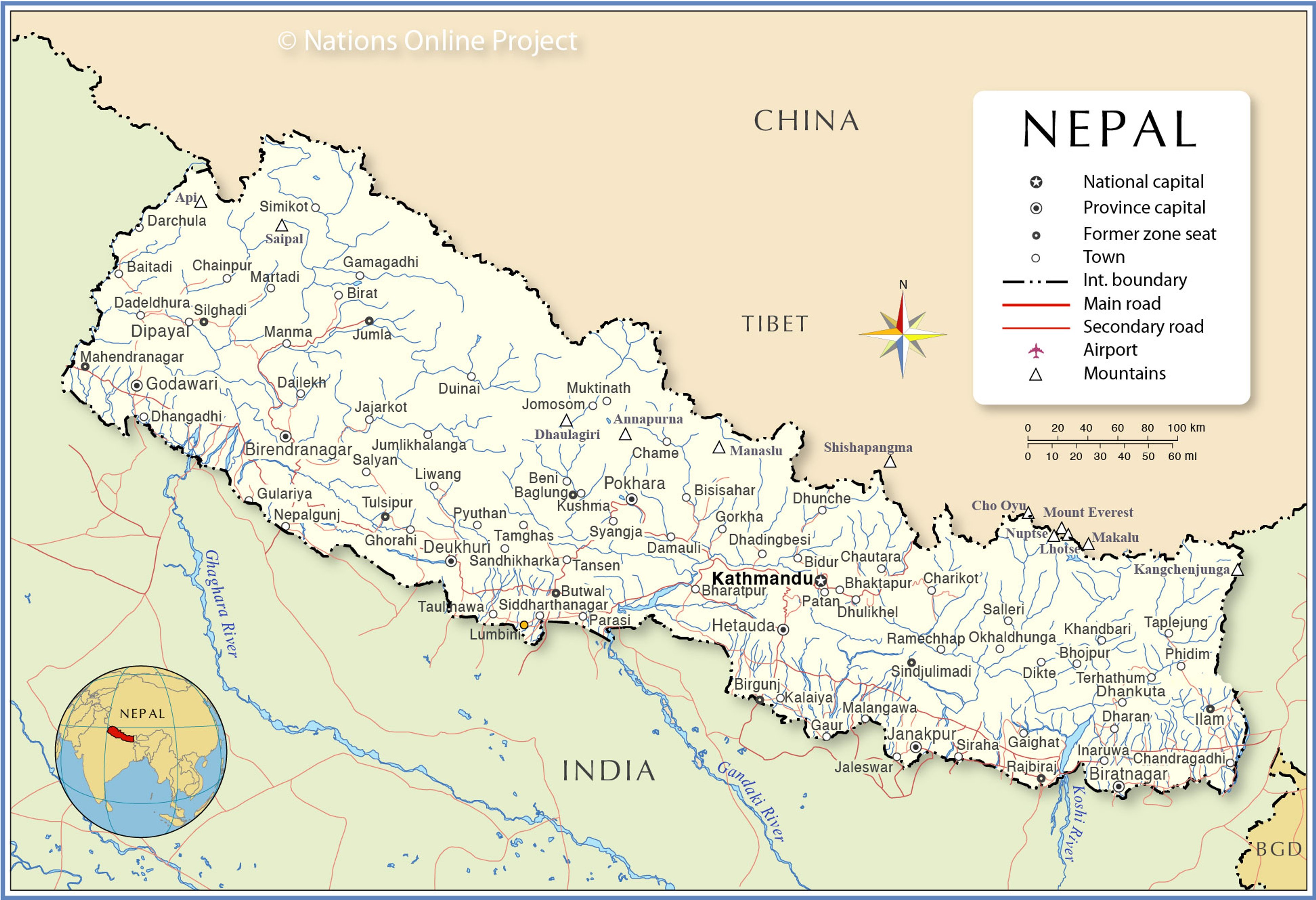
© Nations Online Project
The 1711 Bhūgola
A recently discovered tanka-like painting depicting an entire world as it was visualised in medieval Nepal also exemplifies such creative rivalry.
Click on the image below to explore the fine details of this extraordinary work:
Fig. A - Bhūgola (1711 CE), a painted world map held in The Sunderland Collection.
Since its discovery, I have been fascinated by this work, particularly because I studied a similar piece in gilt metal many years ago, in which the world is depicted as a large, flat disk (Figs. B and C) [2]. The latter is in situ in the Malla Palace of Kathmandu, located within a well-preserved and beautiful courtyard called Mohan Chok.

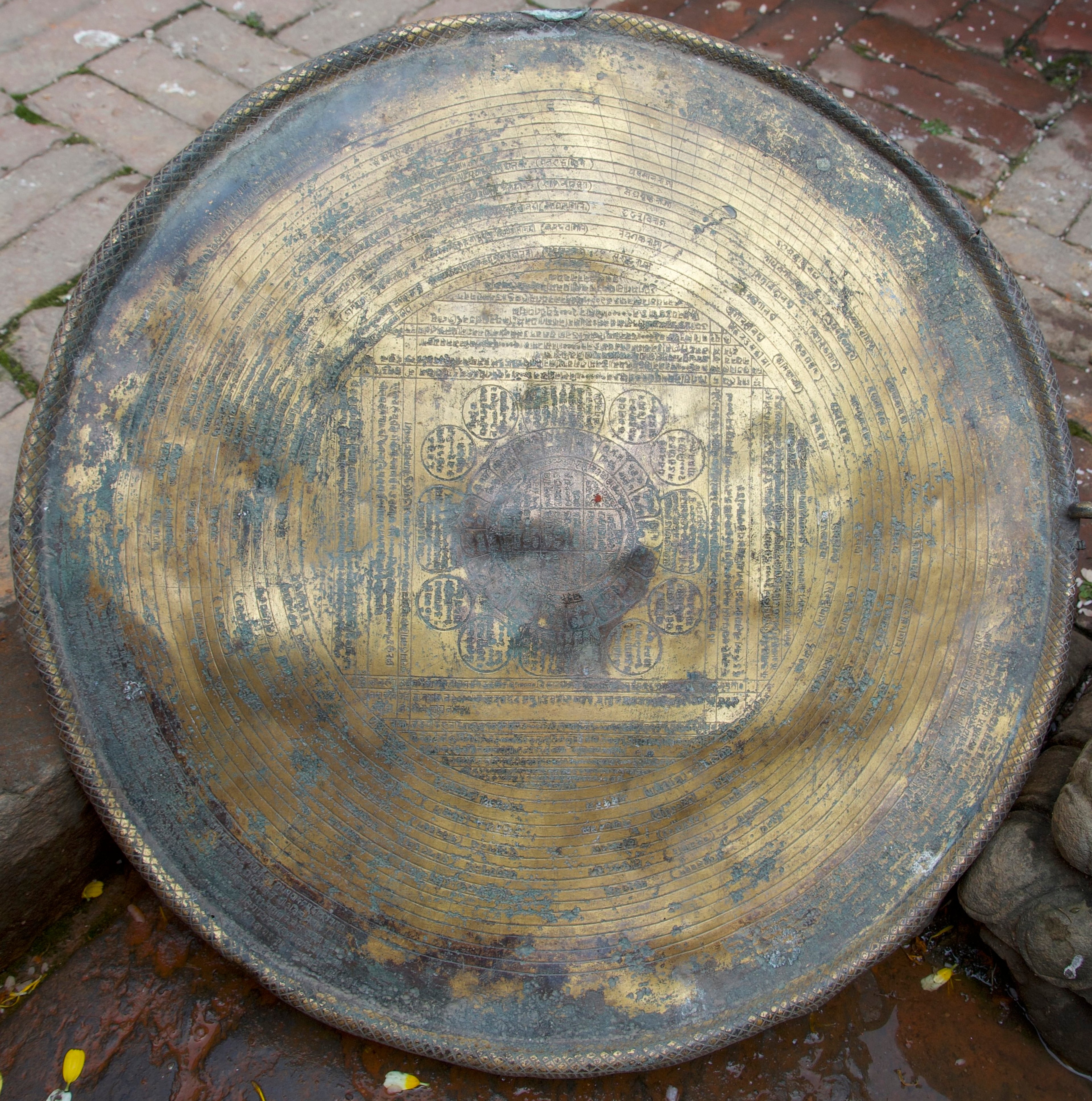
Fig. B and C - Details of King Pratapa Malla’s world map in metal; 1656 CE. ©Gautama V. Vajracharya.
This painterly version of the world map was commissioned by Kirti Simha, a Malla prince of Patan, in 1711 CE [3]. It is fifty-five years younger than the metalwork erected by his father’s uncle, Pratapa Malla (reigned circa 1641-1674), an illustrious king of Kathmandu. The prince must have seen his uncle’s contribution during a royal gathering to celebrate an annual festival or wedding ritual.
In the inscriptions written in both painted and metal works, the world map is referred to as bhūgola, a Sanskrit term meaning "globe" [4]. Undoubtedly, the creators of these works were aware of the astronomers’ view that the Earth is spherical. Still, they chose to depict it as flat and circular, aligning with the popular religious beliefs of their time.
Technical illustration of the Bhugola (paubhā), by Bijay Basukala (2025).
Mapping Medieval Nepal
The ancient astronomers of India certainly understood that the Earth is round and suspended in space. This knowledge conflicted with contemporary Hindu legend, based on the belief that the boar incarnation of the heroic god Vishnu rescued the Earth goddess from drowning in the cosmic ocean. As we see in the following discussion, King Pratapa Malla’s metalwork is partially based on this story. Astronomers, however, argued that if a supernatural being were indeed holding up the Earth, one would need to explain where that being was standing—on the back of a tortoise, which in turn floats on the ocean. Ultimately, this would lead to the conclusion that the base was hanging in the sky.
Additionally, these ancient thinkers, although unfamiliar with the theory of gravitation, noted that while objects fall from the sky, nothing falls from the Earth to the sky. Therefore, there is no reason to worry about the Earth falling upwards. Very likely, this logical argument was primarily circulated among astronomers.
Nevertheless, some artists must have been familiar with such statements. But the representation of bhūgola, both in painting and metalwork (Figs. A, B, and C), was not for showing the world on a global map but as a divine object for darshan and puja (seeing and worship), as mentioned in the inscription given in Kirti Siṃha’s painting [5]. The beauty of medieval Nepal's religious art often stems from a belief in supernatural power and an elevated imagination, rather than deductive reasoning. The representation of the world illustrated in this tanka-like painting is no exception; in fact, it may be one of the most fascinating artistic expressions of medieval Nepal.
Although the word "tanka" is now recognised in English dictionaries, it originates from the classical Tibetan language, where it refers to a vertically elongated, unframed cloth painting intended to be hung on a wall, supported by two wooden rods at the top and bottom. In the Kathmandu Valley, the Newar community prefers to call this type of painting "paubhā.” Our bhūgola painting is actually a paubhā, as it is a cloth painting designed similarly. Since the edges of the painting are missing, the upper and lower folds of the cloth used for inserting the rods are also absent.
Both Tibetan and Nepalese cloth paintings regularly depict the universe presided over by a great god seated or standing at the centre of a fully bloomed, stylised lotus, symbolising the centre of the cosmos (Figs. D and E). Such a composition is known as a mandala.
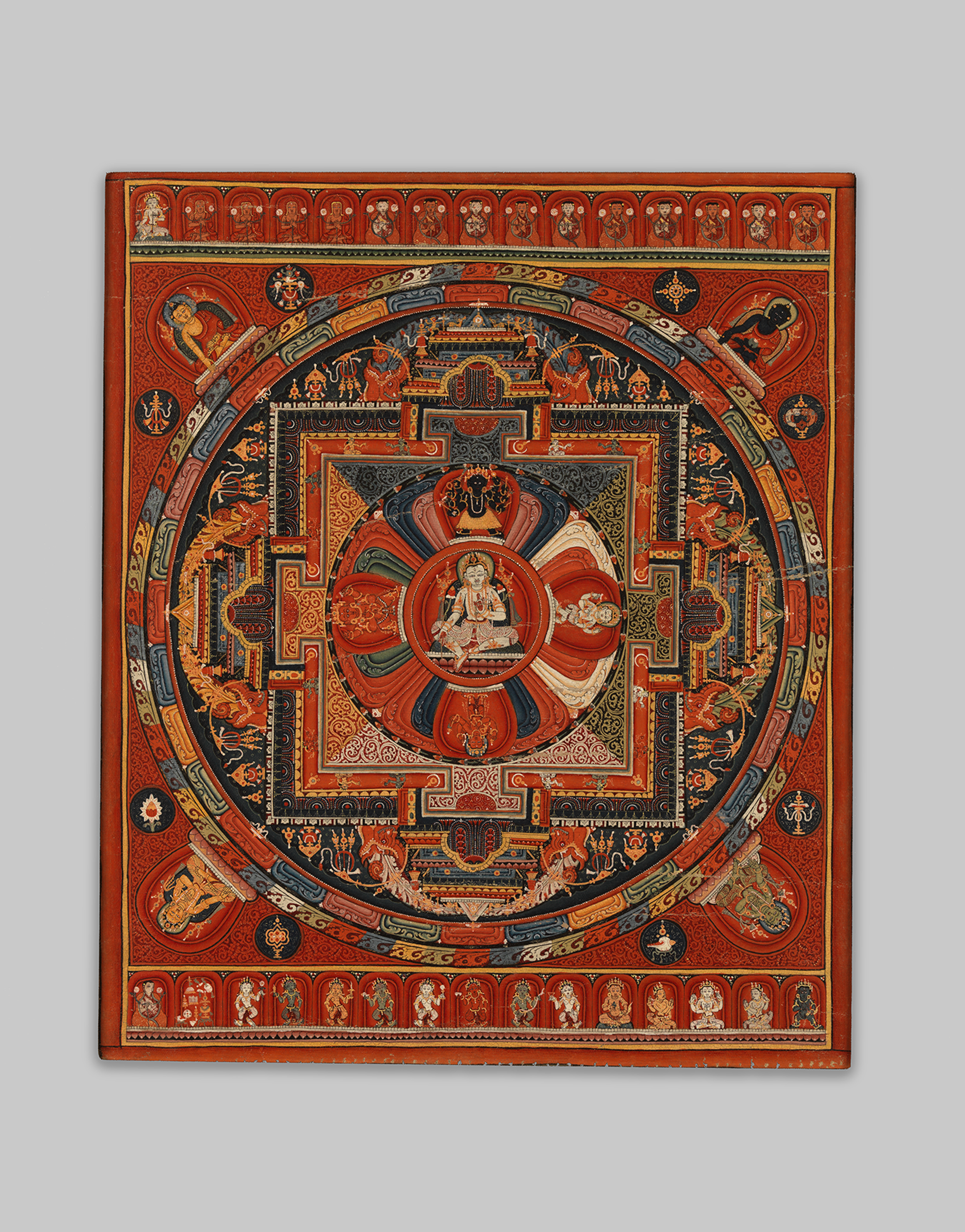
Fig. D - Mandala of Amoghapasha, Northern Nepal or Tsang Province, Central Tibet, 15th century. Pigments on cloth. ©Rubin Museum of Himalayan Art C2004.15.1 (HAR 65345)
In a sense, the mandala paintings are also world maps, which is why we see some similarities between paubhā and our bhūgola painting. For instance, in our painting, we see heaven situated on the stylised eight-petaled universal lotus represented in the central most section of the painting (Fig. F).

Fig. F - Detail of the Central Section of the 1711 Bhūgola ©Sunderland Collection
The main deity of the paubhā painting is also portrayed similarly. (Fig. E).
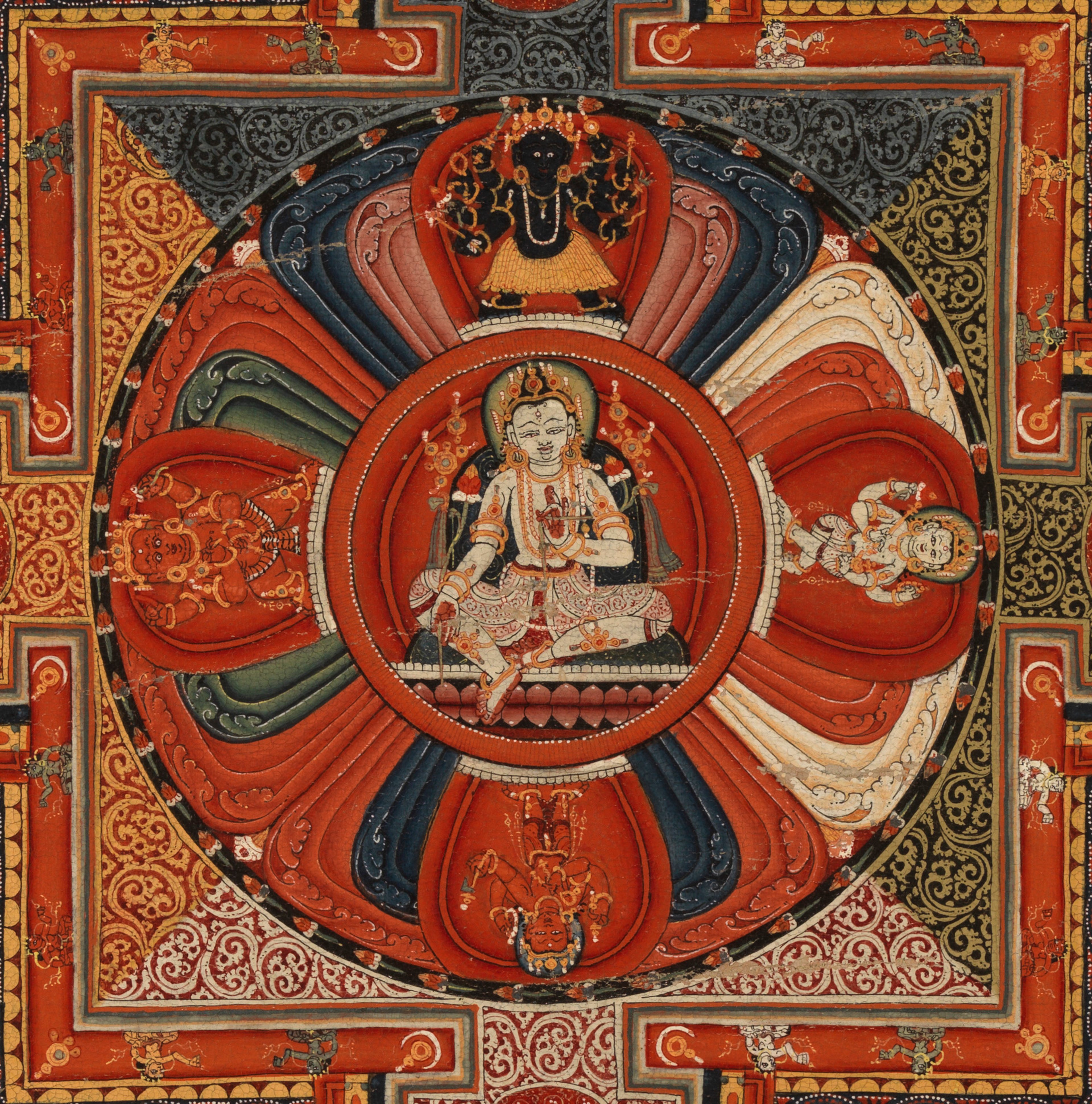
Fig. E - Central section of the Mandala of Amoghapasha, Northern Nepal or Tsang Province, Central Tibet; 15th century. Pigments on cloth. ©Rubin Museum of Himalayan Art. C2004.15.1 (HAR 65345)
A Sanskrit text entitled Viṣṇudharmottara Purāṇa, which deals with the iconography of Indian deities, explains that the lotus symbolises the cosmos. Any deity positioned on the pericarp of the lotus is said to rule over the universe.
In the present example (Fig. F) from 1711, this heaven belongs to the creator god Brahmā, which is designated in the label as Brahmapurī, “the realm of Brahmā.” Despite such similarities, there is an immediately discernible difference that we see between a paubhā painting and our world map. The latter is devoid of a shrine for the main deity. If this were a paubhā painting, Brahmā, the main deity, would have been shown residing inside a golden shrine.
Furthermore, in a paubhā painting, the lotus heaven is typically depicted as well-protected by the gated walls of a square-shaped compound. The four directional gates are always shown in a flat manner without any three-dimensional projection and feature the mythical creature makaras adorning the ends of the architrave (Fig. D). In contrast, the bhūgola painting lacks such magnificent gates. This is likely because its primary purpose is to depict the world itself rather than to showcase the image of the cosmic god presiding over a gated palace-like heaven, as seen in traditional representations.
Influences and Sources

Fig. G - Pratapa Malla’s Boar Incarnation, detail of King Pratapa Malla’s world map in metal; 1656 CE. ©Gautama V. Vajracharya.
Unlike the paubhā and bhūgola paintings, Pratapa Malla’s metalwork is a three-dimensional art form; hence, it features an additional element. Below the circular metal disc, we see the well-known boar incarnation of Vishnu striking a heroic pose (Fig. G).
The four-armed god holds a conch shell, a wheel, a club, and a lotus. He extends his right leg backward and firmly plants his bent left leg on the back of a giant turtle.
In this stance, the boar-headed god is careful enough to stabilise himself in a heroic posture so he can comfortably carry the earth goddess seated on his elbow.
As mentioned previously, this scene is rooted in the popular Hindu legend. The artist of the painterly version of bhūgola could not depict this scene of the underworld in his work because the painting, in a sense, is the representation of the flat world seen from a bird’s-eye perspective.
In contrast, the three-dimensional metalwork illustrates not only the turtle but also multiple layers of the underworld floating in various oceans, as described in Hindu myths, and mentioned in Pratapa Malla’s inscription as well. The oceans are represented below the turtle's feet by semi-circular lines symbolising the ripples of oceanic water.

Fig. H - The 7th-century Boar incarnation of Vishnu in Dhumbarahi, Kathmandu. Photography Gautama V. Vajracharya.
The depiction of the boar incarnation was a prevalent theme in Nepalese art. The earliest example dates back to the seventh century (Fig. H).
The artist of the metal bhūgola was undoubtedly familiar with this national masterpiece. This is why he illustrates the god carrying the Earth goddess on his shoulder almost exactly as shown in the earlier monument, but without considering that he could have avoided redundancy by depicting the god holding the Earth disk instead of the Earth goddess. He chose to represent both and embraced the freedom of artistic expression.
Features on the Bhūgola
If we examine the detail of the painting (Fig. F) more closely, it reveals that the diminutive figure of the bearded creator god Brahmā, positioned at the central part of the painting, wears a crimson-red lower garment called a dhoti and sits comfortably in a lotus posture on the back of a white goose. The goose is one of the animal vehicles (vāhana). Generally, various vāhanas are associated with different Indian gods and goddesses. For example, the white elephant is often linked to Indra, the king of the gods. At the same time, the crocodile-like mythical creature, the makara, is associated with Varuṇa, the god of the celestial and terrestrial oceans. The origin of this concept goes back to the Vedic period (ca. 1500-600 BCE).
Notably, the lower body or the navel of the creator god is shown here as the source of four great rivers of the world flowing in four cardinal directions (Fig. F).
In the label inscriptions, the rivers are designated as Alakā, Sitā, Bhadrā, and Vakṣu. All these rivers are regarded here as the branches of the Ganga, the most famous sacred river of northern India, which is believed to be descending from heaven. In the legend of Shiva, the Ganga descends from his matted hair. This popular legend contrasts with the story of Brahmā depicted in this painting.
Before we proceed with our discussion, it is essential to note that, unlike in our modern-day maps, in this traditional world map, the east and west are positioned at the lower and upper sections of the map, respectively, and the north and south are located on the viewer’s left and right, respectively. This rule is also strictly adhered to in mandala paintings, with no exceptions [6]. In accordance with this system, the petals of the universal lotus, which appear like a circle, are shown here, inhabited by the great gods of the eight directions. Indra, the guardian god of the East, occupies the bottom-most petal of the universal lotus. He is easily recognisable by his vāhana, a white elephant on which the god is shown seated. The other guardian gods are depicted here in the circle and arranged in a clockwise direction.
The following is the list of the gods of the eight directions and their attributes:
Name of the God:
Indra
Agni
Yama
Niṛti
Varuṇa
Vāyu
Kuvera
Iśa
Direction / Colour:
East / White
Southeast / Red
South / Dark Green
Southwest / Red-Brown
West / White
Northwest / Dark Green
North / Red
Northeast / White
Vāhana (animal vehicle):
Elephant
Goat
Water Buffalo
Corpse
Makara (Crocodile-like creature)
Deer
Horse
Bull
The circular universe of these directional gods is surrounded by dark blue stylised mountains, highlighted by golden lines. The number of mountains is nineteen. They are identified by names such as Śaṃkha Parvata (Conch Shell Mountain), Vaidūrya Parvata (Coral Mountain), and Haṃsa Parvata (Geese Mountain), among others.
All these high mountains are rendered in a circle, and in turn, they are encircled with red-hot burning fire, indicated by stylised flames. Thus, the central heaven, visualised as an eight-petaled giant lotus, is surrounded by many mountains and a circle of fire. This central heaven is not easily accessible to anyone because it is situated in a dark green space that resembles a quadrangle valley walled by additional mountain ranges and deep water (Fig. I).

Fig. I - Central portion of the world, detailing stylised rivers and mountains bordering the centre of the cosmos.
We also see a similar space depicted as a courtyard rather than a valley in tanka paintings. Following the nomenclature of palatial architecture, in texts dealing with mandala iconography, the courtyards are referred to as antarāla, or “inner courtyard.” In fact, a careful study of such texts reveals that most Mandala paintings are based on the imagery of the cosmos viewed as a universal empire with a palace in the capital city, protected by several layers of gated walls and moats. Although our world map is also designed with a similar view, here, the walls are not brick walls but high mountains. The number of layers of the square walls is eight.
This square space is again surrounded by seven waters flowing in circles, which are connected to seven rivers that look like spokes on our circular map (Fig. A). These seven waters likely represent the seven major rivers (sapta sindhus) of Vedic India. These rivers, in turn, are connected to many other rivers, apparently emerging from mountains. The dark green, mountainous regions are home to a diverse array of birds and animals, including peacocks, parrots, lions, elephants, and deer (Fig. J).
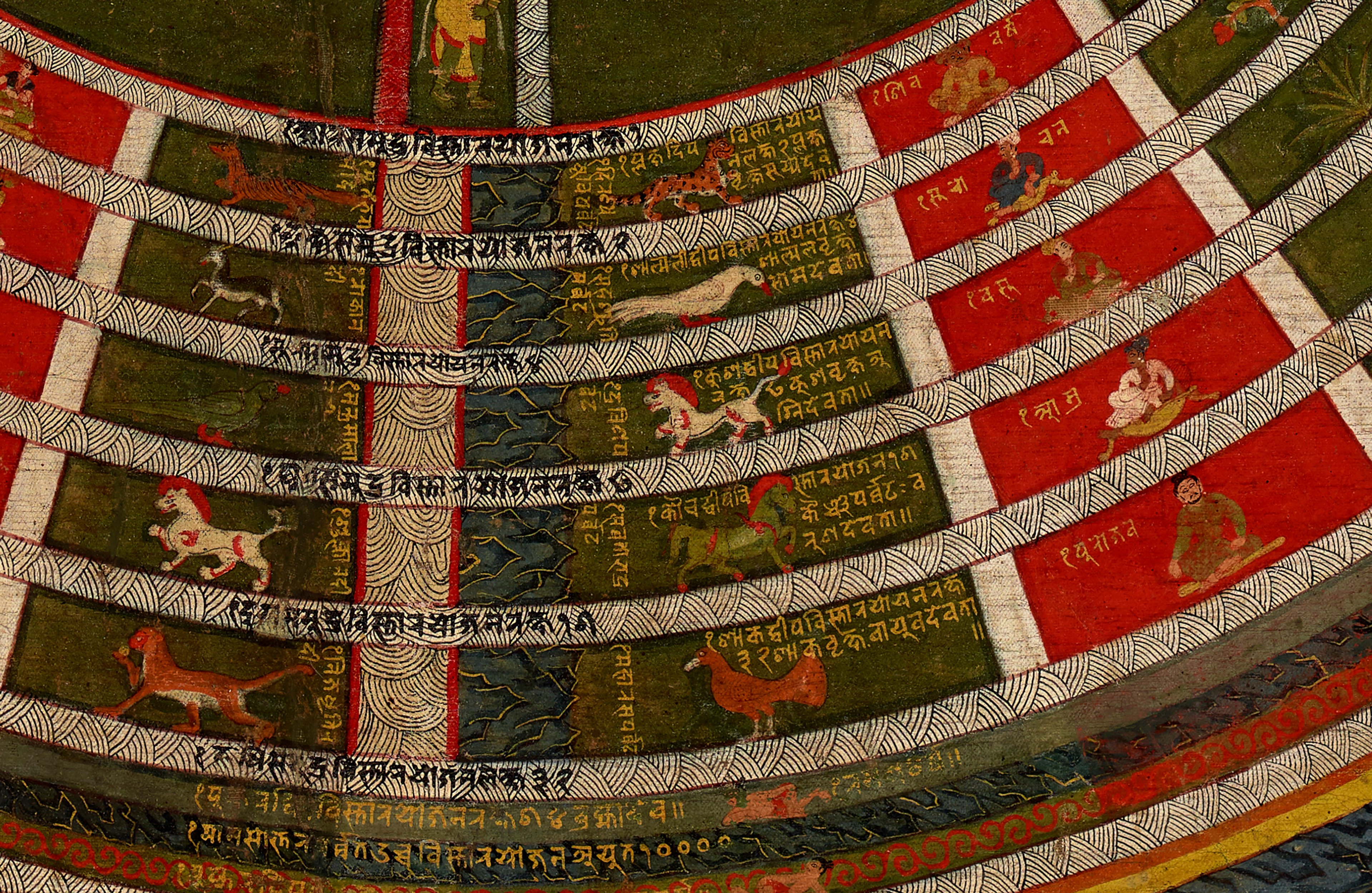
Fig. J - Close up of the concentric ring featuring the birds, animals and Royal figures of Nepal.
Surprisingly, no fish are depicted as denizens (inhabitants) of this cosmos. Perhaps the green makara, a crocodile-like mythical creature that symbolises the ocean, was considered suitable enough to represent aquatic creatures. Nepal is a landlocked country, and it is almost sure that the artist - as a resident of the Kathmandu Valley - has never seen an ocean or any oceanic creature.
In the crimson-red oblong spaces, bordered by rivers and mountains, we see not only birds and animals, but also various mythical kings seated in simple, traditional royal seats in a relaxed manner (Fig. J). Some of the kings have interesting names, such as Subhadra, Ramanaka, Dṛḍharuci, etc. The great kings, such as Yudhisthira and Rama, from the Indian epics, the Mahabharata and Ramayana, are not enumerated here, perhaps because they were considered historical rather than cosmic. According to ancient South Asian belief, the cosmos represents both space and time.
Although this brief study cannot include all the details, it would be incomplete without sharing the true story of the young prince’s acceptance of the challenge presented by his father’s uncle, Pratapa Malla. The Malla king was a multitalented, charismatic figure. He expanded his palace tastefully, commissioned multiple artworks, practiced tantric rituals, composed verses in Sanskrit, claimed to be well-versed in shastras, and showed interest not only in antiquity but also in learning various scripts and languages, including the Roman script [7]. Realising the significance of antiquity was indeed unprecedented. Even today, people still struggle to understand it fully.

Fig. K - Greco-Roman Goddess Aequitas, holding a cornucopia and weighing scale, depicted in a Stone Panel commissioned by King Pratapa Malla. ©Gautama V. Vajracharya.
Additionally, a panel of relief sculpture in his palace attests that the Malla king was familiar with the iconography of the Greco-Roman goddess Aequitas, holding a cornucopia and a weighing scale (Fig. K), and was fascinated not only by the luxurious Western lifestyle, characterised by indulgence in exotic grapes, wine, and captivating women dancing to music, but also by the optical instrument, a monocular that he received as a gift from a foreign visitor (Figs. L and M). In Figure L, a child leaning towards his mother is shown playing with the instrument.
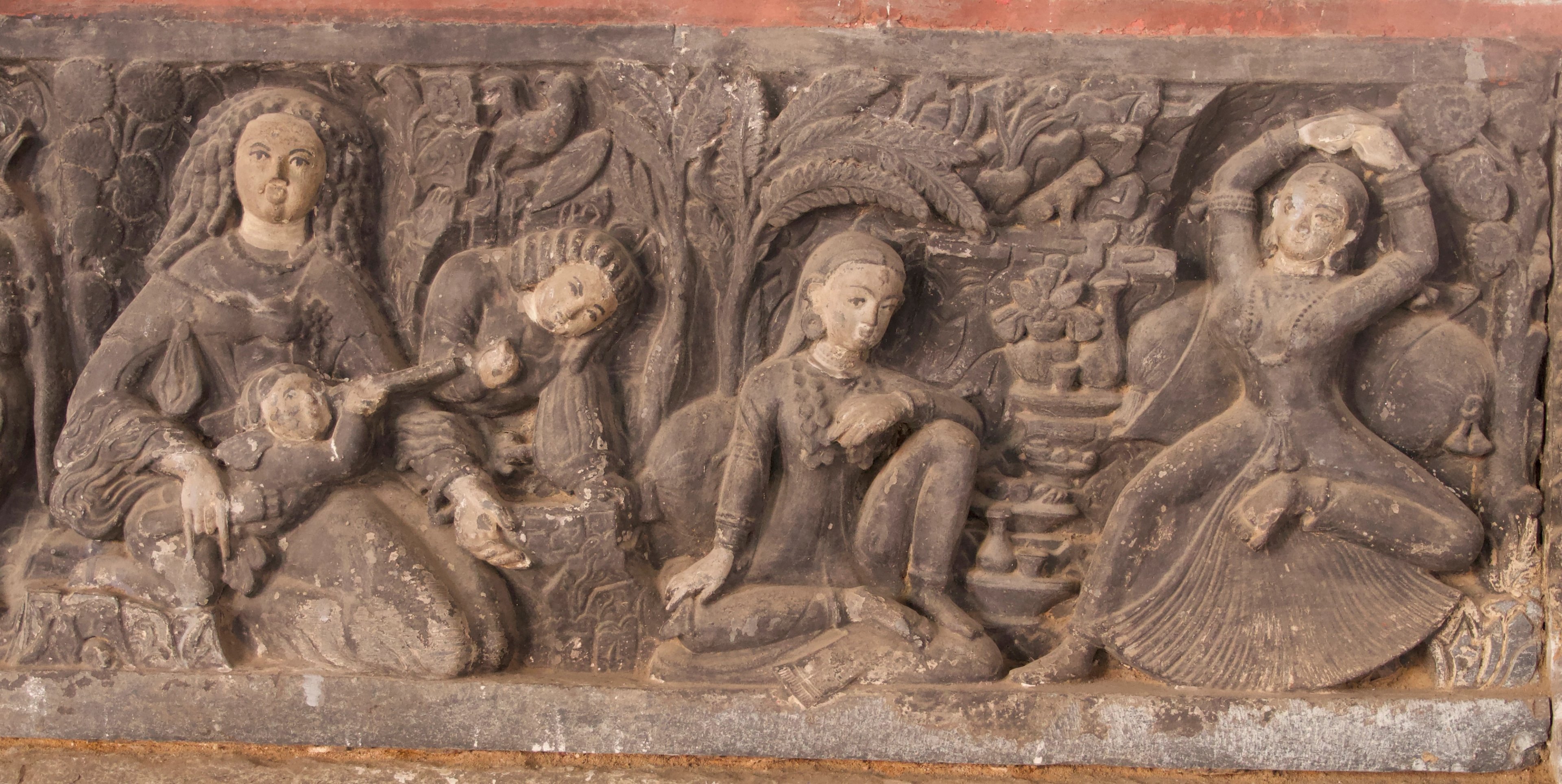
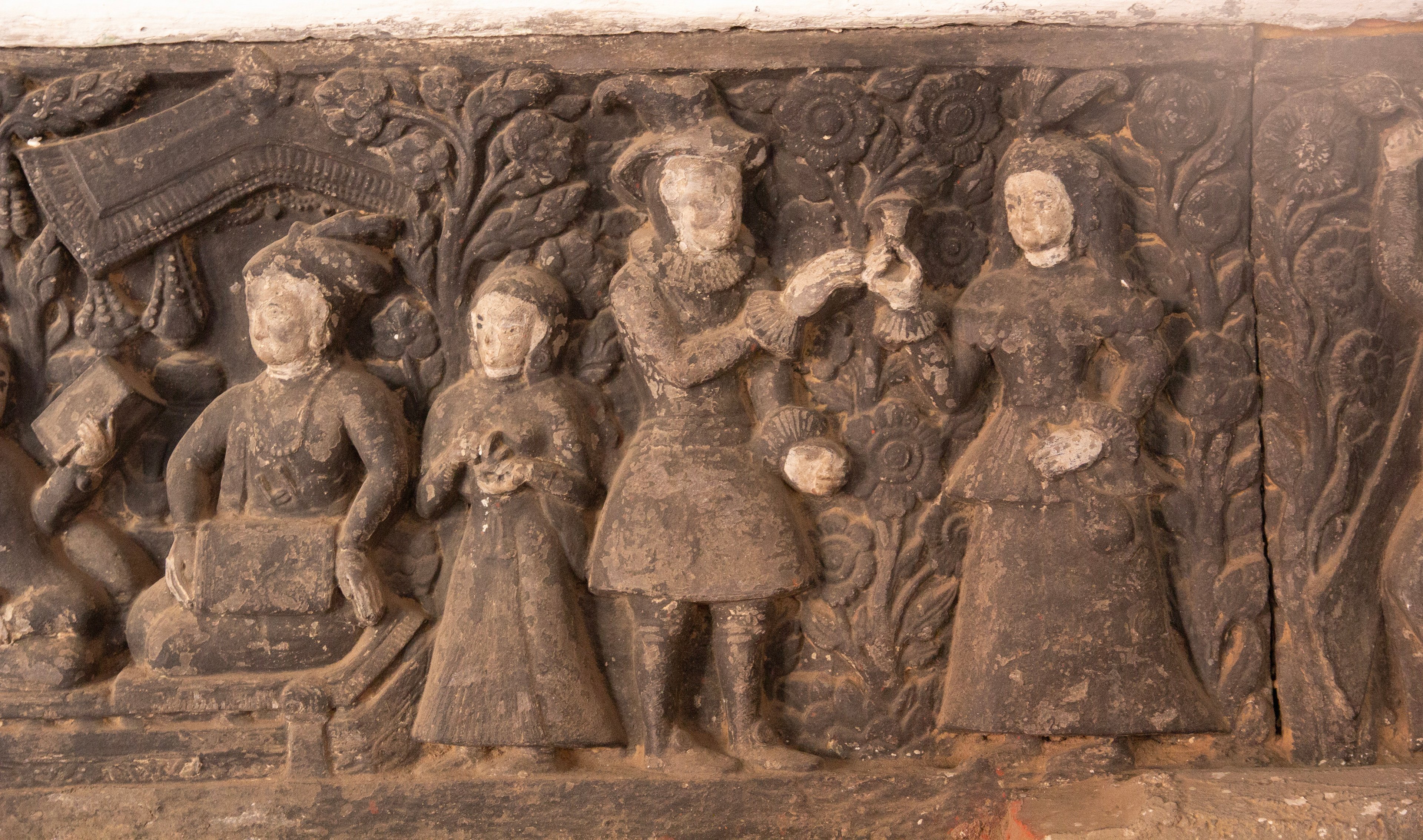
Figs. L and M - Western lifestyle depicted in stone panels commissioned by King Pratapa Malla. ©Gautama V. Vajracharya.
One of the Malla king’s significant contributions is also a massive monolithic water tank placed on the wall of his palace, facing the public courtyard, clearly designed to provide water to his subjects. However, the water tank has additional significance. The surface of the water tank features a lengthy inscription in multiple languages and scripts. In the inscription, the scholar king challenges the intellectuals of his time, declaring that if you cannot read and understand this inscription, you should not consider yourself a scholar. The exact words he used to convey this message are so offensive that they cannot be translated here.
Although in his bhūgola inscription, Pratapa Malla does not explicitly challenge people to uncover the source of his knowledge regarding the world map he created, he does so indirectly by stating that he crafted the world map under the guidance of a Shastra. However, he does not specify which one. In fact, this was another challenge that he presented to Intellectuals of his era, who must have attempted to identify the source text of the world map that he created. But their efforts were in vain until Prince Kirti Siṃha discovered a detailed description of the map in a Sanskrit text known as the Vāyu Purāṇa.
When I published Pratapa Malla’s bhūgola inscription more than fifty years ago [8], I also attempted to identify the name of the Shastra on which the depiction of bhūgola is based. My colleague, Prof. Gudrun Bühnemann, has also attempted this recently, with limited success [9]. Thus, Pratapa Malla’s challenge inspired not only his contemporaries but also modern scholars. This is undoubtedly a key reason why the discovery of Kirti Siṃha’s bhūgola painting is so thrilling.
The artist of this bhūgola painting was indeed an accomplished artist. The naturalistic depiction of birds and animals, including parrots, peacocks, spotted deer, and elephants, showcases his remarkable ability to capture the playful characteristics of the creatures. The juxtaposition of colour backgrounds, such as crimson red versus dark green, suggests that the artist was familiar with the tradition of this treatment, as seen in centuries-old Nepalese manuscript paintings. However, following the prevalent style of his time, the artist depicts all divine and human figures either in profile or from a frontal view, avoiding a three-quarter profile, which was a dominant feature in earlier Nepalese paintings. Likewise, foreshortening is not used anywhere in showing animals and birds. This approach is grounded in the Rajput style of painting from India, which was introduced in the valley just a few decades before this artwork was created.
The Newar traditional method of rendering water with semi-circular lines and portraying high mountains with overlapping conical lines in gold remained unchanged. Unfortunately, the artist's name is not included in the inscriptions.
Traditionally, Nepalese artists do not inscribe their names on their paintings or sculptures. Notably, when artists create works for their own enjoyment rather than for a client, they typically do include their names. Only a few exceptions exist to this unwritten rule.
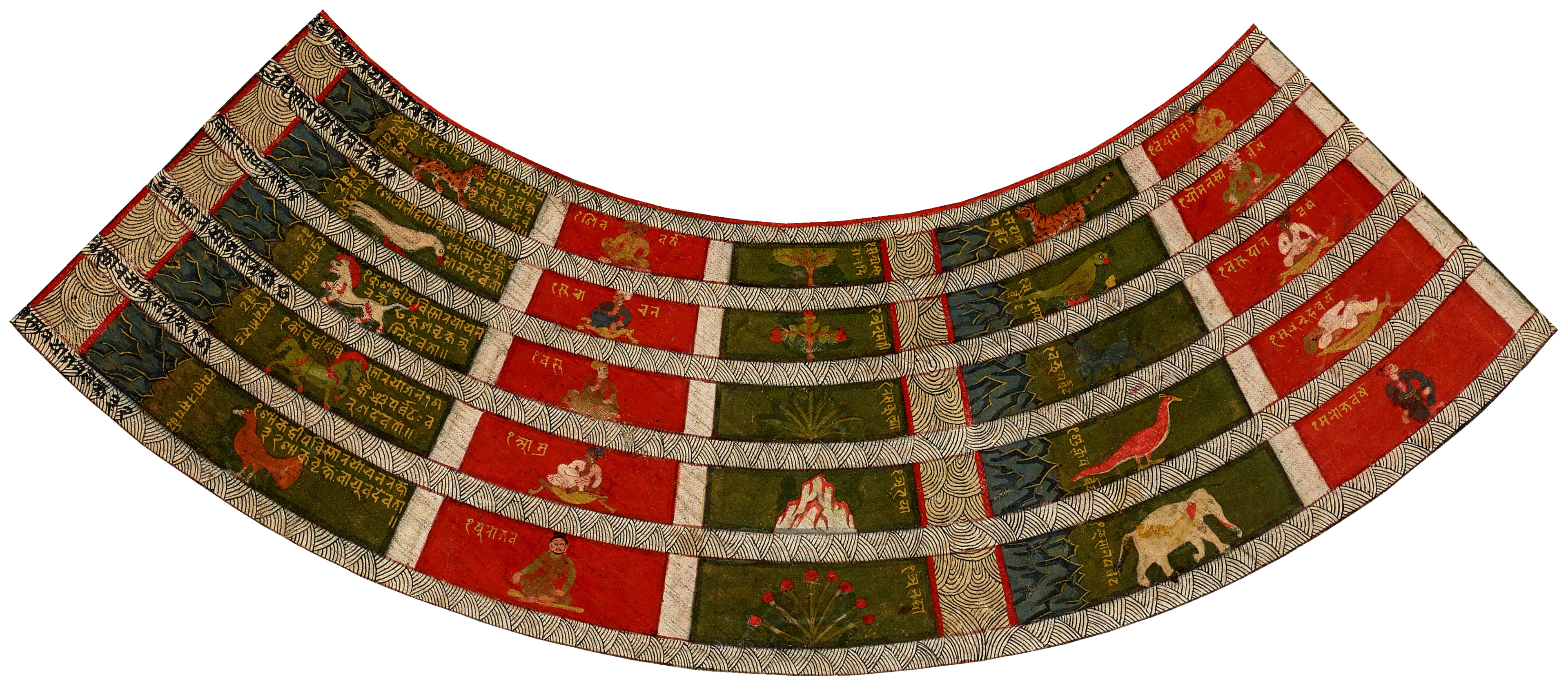
Appendix
Inscriptions
Across the map there are numerous label inscriptions referring to the mythical and actual names of the rivers, oceans, mountains, lands, islands, and monarchs of the regions.
Here is the translation for the key inscription above the circular configuration of the world map. This section of inscriptions provides essential information about the date of the painting, the patron, and the purpose of commissioning the world map. Most of this inscription is in Sanskrit. The last two sentences are in classical Newari.
Text
- oṃ vāyupurāṇe || saptarṣīn satyalokaṃ ca | dhruvaṃ bhūgolamaṇḍa(la)m | bahujanmārjitai puṇyai jantū na(ra)rśa(bho) bhavet | yena dā(nā)dyupāyena da-
- rśanaṃ śubha(maṃ)galān xxxxxxxnāṃ vā | śailamṛṇmayadārusu || pūjayitvā likhitvā vā xxx phalaṃ labhet || yaśaśvit sukṛtī
- xx bhūgolaṃ svarṇasaṃskṛtam | dadāti vedaviduṣe tasyā muktikaro sthitā || praṇamed vātha yaḥ kuryyā, bhūgolaṃ ca dinadine ||
- tasyāyurvaddhate nityaṃ, lakṣmī ca vipulā bhavet || (ba)havaḥ bhu(va)nastuti vistarabhayād (na li)khi(tāḥ) || || bhūgolaṃ pā mahimātra
- chasa yako do, tha pachibhāya juko coyā || oṃ śrīmat cchrīśrīśrīlokanāthasya | śrījayaśrīyoganalendramallasya xx kāya (śrī) kīrtisiṃhana tho phūgola nityadarśaṇa
- yāṅā coṅā | saṃmvat 832 kāttika śukla pūṇami || śubha ||

Translation
As mentioned in the Vāyupurāṇa, anyone who worships the seven stars of the Ursa Major constellation, the Pole Star, and the mandala of the world map becomes a prominent figure, as if he has accumulated religious merits in his past lives.
Similarly, one who creates a world map from stone or mud and worships it becomes renowned and virtuous. If he donates a golden globe (bhūgola) to (a brahmin) who is well-versed in the Vedas, he will attain ultimate liberation (mukti). By bowing to the world map daily, he will gain longevity and wealth.
Numerous verses address this subject. They are not quoted here to maintain conciseness. References to the bhūgola can be found in many places. Only those references necessary for this paubhā are provided here.
I bow down to the great god Lokanātha. On the full moon day of Kārtika month (October/November) of Samvat 832 (CE 1711), Kirtisimha, the son of the victorious great king Yoganarendra Malla, commissioned this bhūgola for the ritual of darshan, which he performs every day. May it be auspicious.
We would like to extend our thanks to Dr. Gautama Vajracharya for this wonderful article and research on The Sunderland Collection's 1711 Bhūgola. And additionally for the fantastic illustrative contribution from Bijay Basukala.

About the Author
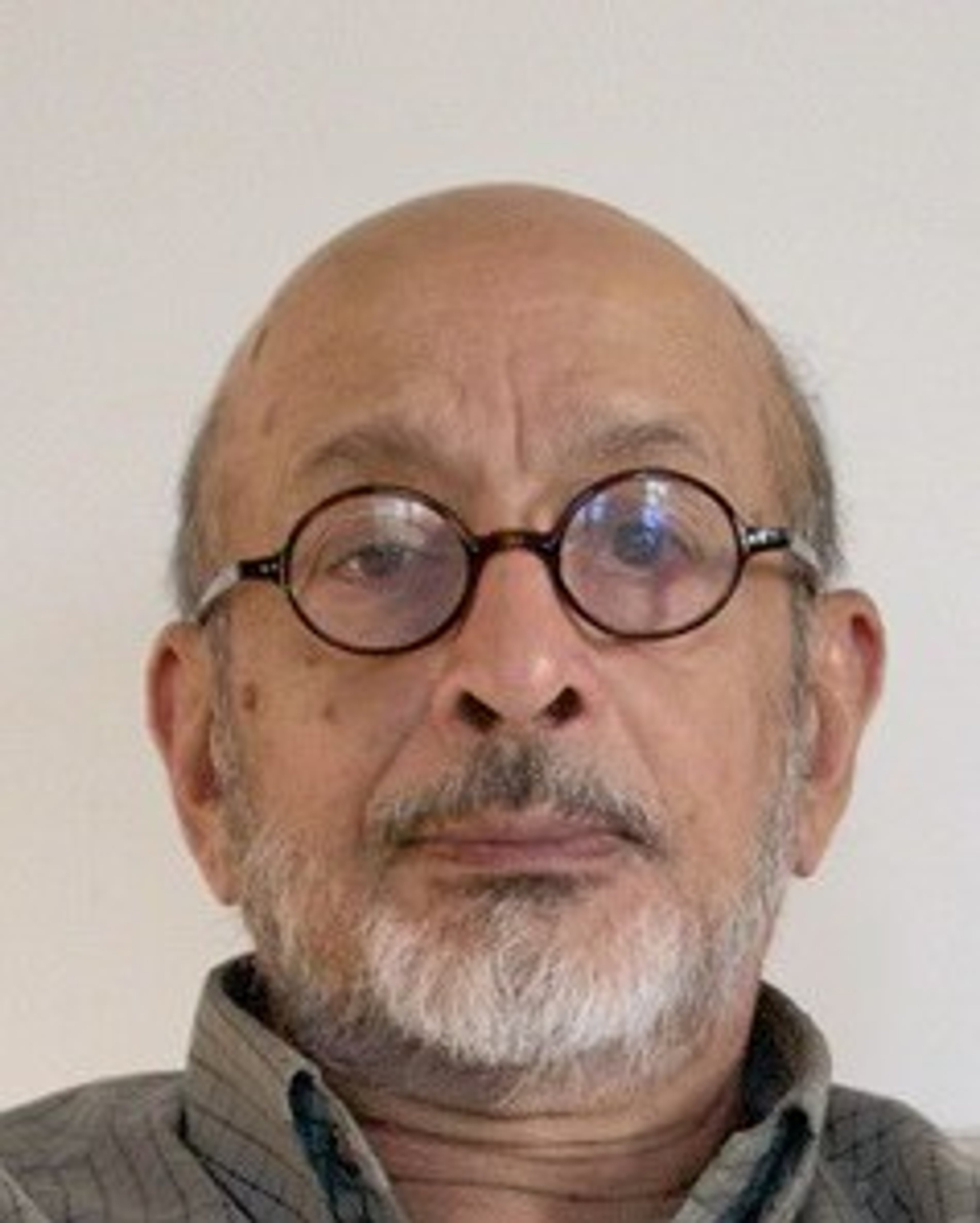
Dr. Gautama V. Vajracharya is a Sanskritist and scholar specialising in the art and culture of South Asia.
He studied Sanskrit in a traditional school in Nepal. As a young scholar, he received a prestigious Rockefeller grant to work as a trainee at the Los Angeles County Museum of Art.
Dr. Vajracharya earned a Master of Arts in Art History from Claremont Graduate School in California, and a PhD in South Asian language and culture from the University of Wisconsin, Madison.
He taught Indian art and culture at the University of Wisconsin for more than two decades. Among his most recent publications is the book Frog Hymns and Rain Babies: Monsoon Culture and the Art of Ancient South Asia. He was the guest curator for the exhibition “Nepalese Seasons: Rain and Ritual “ (May 6, 2016 – March 27, 2017) at the Rubin Museum, New York, and authored the accompanying exhibition catalogue.
About the Technical Illustrator
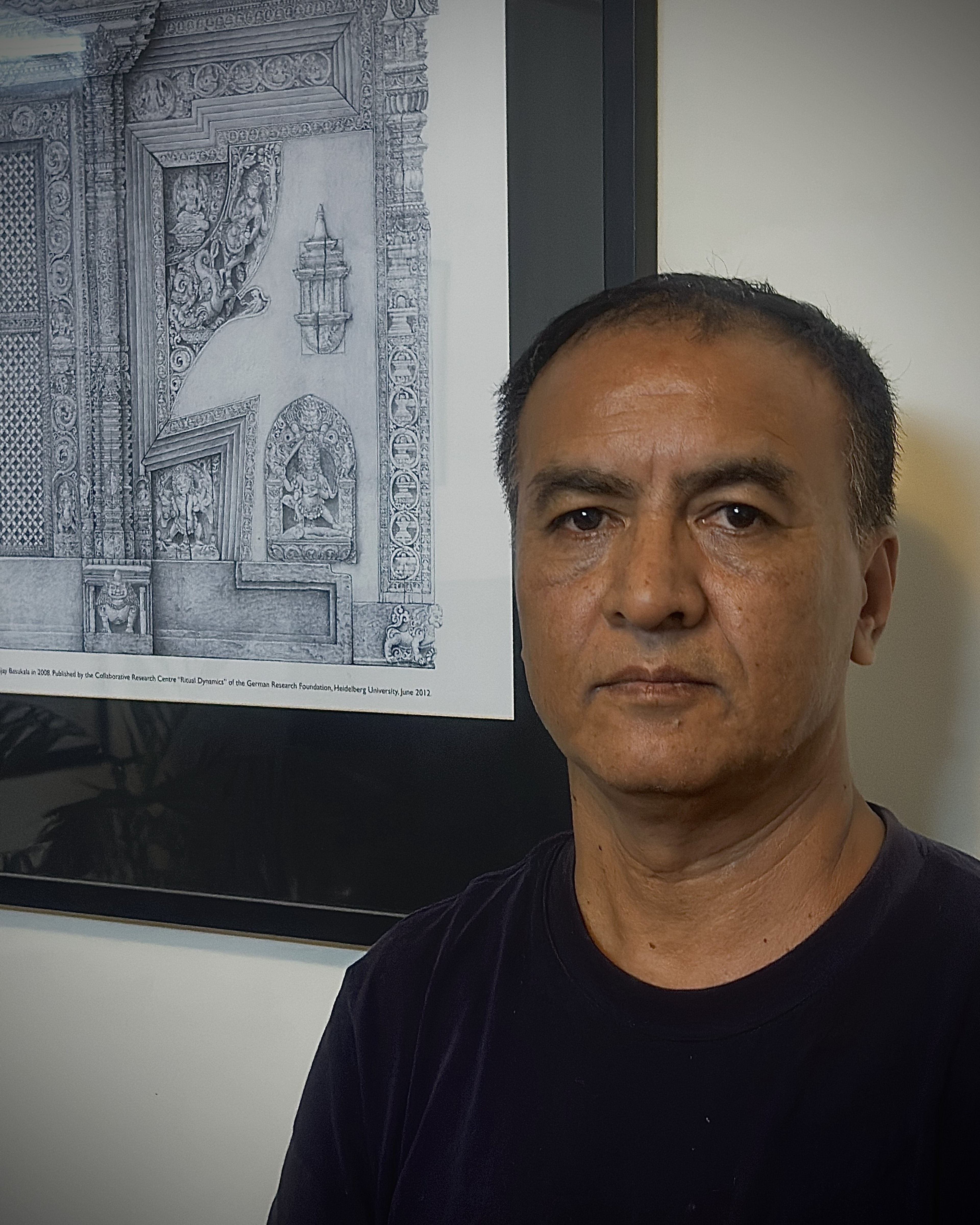
Bhaktapur-born engineer and draftsman Bijay Basukala is an expert in Newari architecture. He has been collaborating with Prof. Dr. Niels Gutschow for the past 36 years, documenting the wonderful architecture of Nepal and illustrating various elements of the country's tangible heritage.
"Creating the recent Nepalese paubhā was deeply in line with the type of work I do - it brought me immense joy and fuelled my enthusiasm from start to finish."
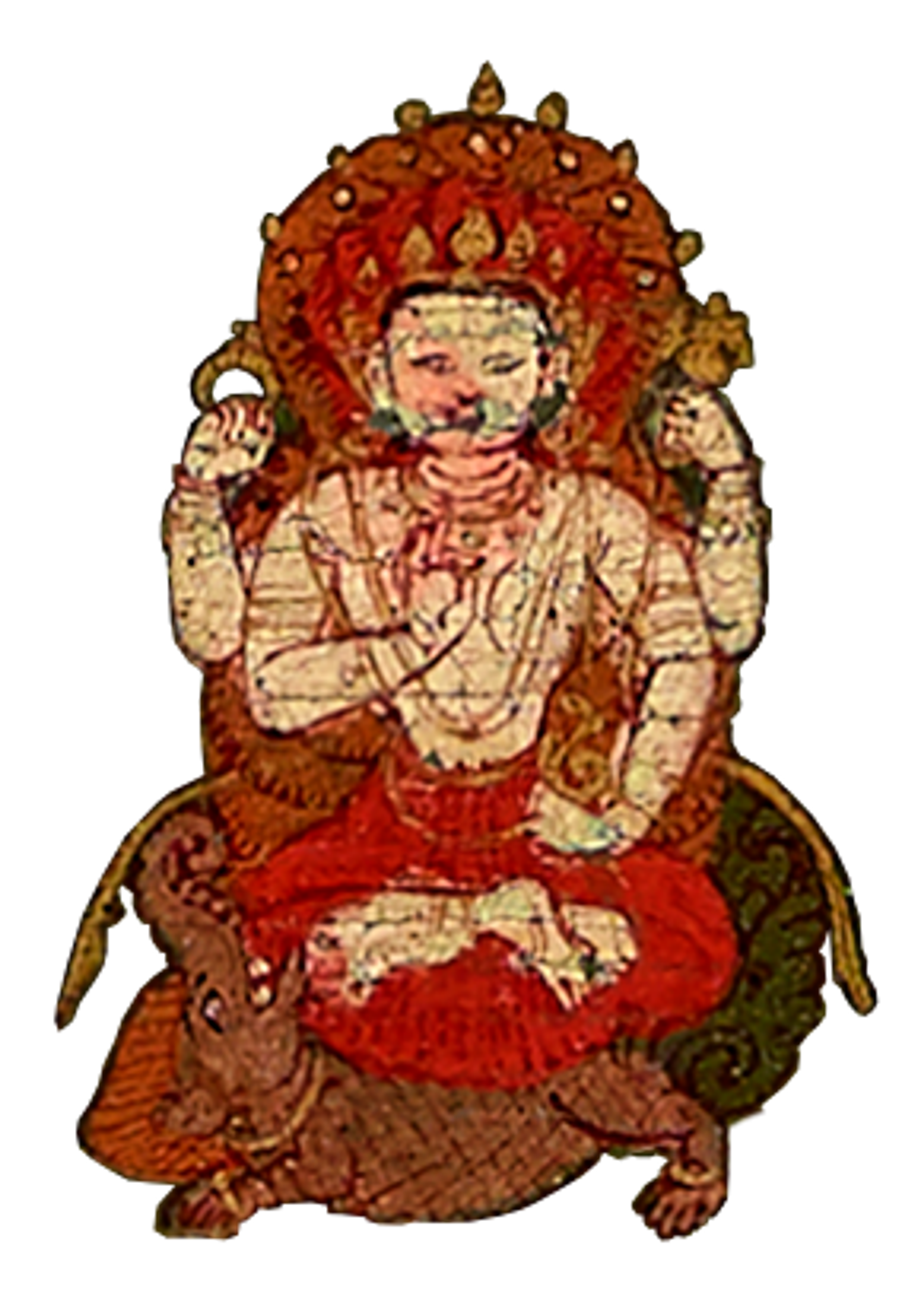
References and Notes:
[1] Madanjeet Singh, Himalayan Art, New York: UNESCO and New York Graphic Society LTD, 1968, pp. 162, 196-198; Gautama V. Vajracharya, “Golden Fountain of Bhaktapur,” in Karl Debreczeny and Elena Pakhoutova (ed.), Himalayan Art in 108 Objects, pp. 320-323.
[2] Gautama V. Vajracharya, Hanumandhoka Rajadarabara (in Nepali), Kirtipur: The Institute of Nepal and Asian Studies, Tribhuvan University, 1975, pp.105, 212-217.
[3] See the inscription found in the painting and its translation in the appendix.
[4] Although the painting depicts not only the world but also heaven and the netherworld, we prefer to call it a world map because, in the inscription, it is designated as a bhūgola globe.
[5] Ibid.
[6] There are several map-like medieval period Nepalese paintings depicting various sacred locales. Some are vertical, while most of them appear horizontal scroll paintings. The creators of these artworks did not strictly adhere to the rules of mandala paintings; consequently, the east is not always at the bottom of these works.
[7] Mary Shepherd Slusser, Nepal Mandala: A Cultural Study of Kathmandu Valley, Princeton: Princeton University Press, 1982, pp. 191-194.
[8] Gautama V. Vajracharya, Hanumandhoka Rajadarabara (in Nepali), Kirtipur: The Institute of Nepal and Asian Studies, Tribhuvan University, 1975, p. 105.
[9] Gudrun Bühnemann, A Model of the Universe in Kathmandu’s Old Royal Palace, History of Science in South Asia, 2020, pp. 1-12. http://hssa-journal.org.
View the Bhūgola in the Collection here.